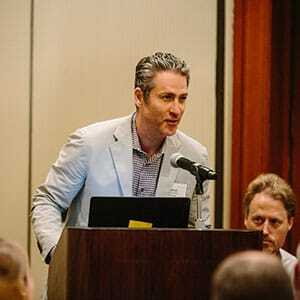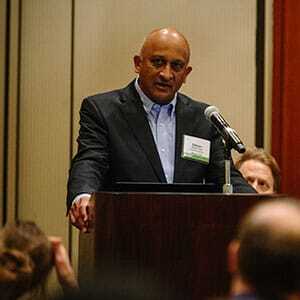In 2015, when entrepreneur Aaron Holm was seeking funding for Blokable, his modular smart housing startup, he encountered a venture capital (VC) landscape that was reluctant to step into the affordable housing arena.
Fast-forward one year and numerous VC firms are jumping into the growing market for technology-based solutions for the affordable housing issues that communities around the globe are facing. “The capital markets are waking up to the fact that this is a huge problem and we’re going to need technological solutions,” Holm, a former Amazon manager, said during a panel discussion at the ULI Housing Opportunity 2017 conference in New Orleans.
Blokable’s system of configurable, connectable modules is intended to deliver move-in-ready building blocks to create homes and communities faster and cheaper than is possible using traditional construction methods. The flexible and stackable spaces—available in lengths from 18 to 38 feet (5.5 to 11.5 m) and outfitted with smart home technologies—allow for the creation of single- or multistory living spaces.
Holm said that the firm has been able to easily recruit top-notch software talent because developers are passionate about solving a problem as large as affordable housing. “People in the tech industry, software developers—this is a brand-new space for them, and they love the idea that they can really start working on something that’s going to affect people’s lives,” he said.
The panel was moderated by Poonam Mathis, founder of real estate technology company StealthForce, which has developed a global network of real estate investment consultants that it connects to investors and other stakeholders throughout the construction process. The result is an on-demand, gig-based marketplace for the real estate industry that is supported by cutting-edge software solutions.
Mathis said the company’s network of 1,000 consultants are skilled in every phase of the investment value chain, which means that StealthForce can offer small companies complex services they might not otherwise be able to afford while also providing larger firms specialized local expertise on a project basis. “Neither size nor stage renders you immune to the gap in resourcing for insights,” she said.
Also on the panel was Satyen Patel, the executive chairman of Prescient, a technology company that is bringing lean manufacturing systems and software to the building industry. The company is out to transform the fundamental economics of multiunit projects with its technology-based solution for the planning, design, construction, and operation of multiunit living environments.
The company says it can cut project times by months and costs by more than 30 percent by allowing the structure and engineering details that will eventually be built on site to be captured in a fully detailed, 3-D virtual model during the earliest stages of the design process. “I believe that 90 percent of the savings of waste actually happens before the project even starts digging, and that’s our focus,” Patel said.
The Denver-based company has constructed 6 million square feet (557,000 sq m) of buildings over the last five years and plans to be in 17 states this year, with expansion into international markets targeted within two years.
Patel, who has a background in software development, said he was attracted to the industry because he wanted to help solve the global housing problem. “The affordable housing challenge is real, it’s here, and I think the opportunity for multiple players to attack that from different ways . . . is enormous,” he said.
Panelist Jonathan Tate of OJT, an architecture and urban design firm in New Orleans, described his firm’s innovative “starter home program” in that city. The program identifies overlooked or nontraditional properties throughout New Orleans and designs custom residential units tailored to each individual lot.
The program began with an analysis of vacant land in New Orleans, which turned up more than 5,400 parcels previously not considered good candidates for housing because of their location, shape, or size. OJT decided to focus their efforts on a handful of these lots close to the city core in neighborhoods that were experiencing rising property values that were driving longtime residents out of the area.
The company has been working on 17 of these projects throughout the city, including a completed, sold, and occupied single-family home on a tiny parcel that had been ignored for decades. Using a vertical design, the firm crafted a modern ten-foott-by-45-foot (3 by 14 m) house with 975 square feet (91 sq m) of living space that fit in the lot without requiring any zoning variance. “It was important to us to not just say, ‘Hey, you can do it,’ but to see how the work itself began to instruct policy positions and set land use levels,” Tate said.
Also during the panel, Columbus, Ohio–based architect Jonathan Barnes introduced his new nonprofit organization, Betterhood, which aims to improve economically distressed communities through innovative, high-quality housing and social entrepreneurship. The organization is tackling the issue of substandard rental housing in urban neighborhoods, but not through the traditional method of policing problem landlords. Instead, Betterhood aims to help neighborhood residents become owners and managers of local properties.
The “entrepreneurial housing” project that the organization has designed includes rowhouses with an owner’s unit on the first floor and two apartment units on the second and third floors that are accessed by a shared apartment corridor. The design is modular and scalable so that it can fit into almost any urban neighborhood.
Barnes, who did not outline a time frame for the project, said that resident owners benefit by acquiring property management skills and experience as well as by building rental income and equity in their property. Those who prove to be successful become eligible to invest in a separate 21-unit apartment complex on the same site.
“We see this as building a community, not just for the tenants . . . but also a community for the owners where they can trade information and go to each other with issues about maintenance or marketing or whatever it might be,” Barnes said.






